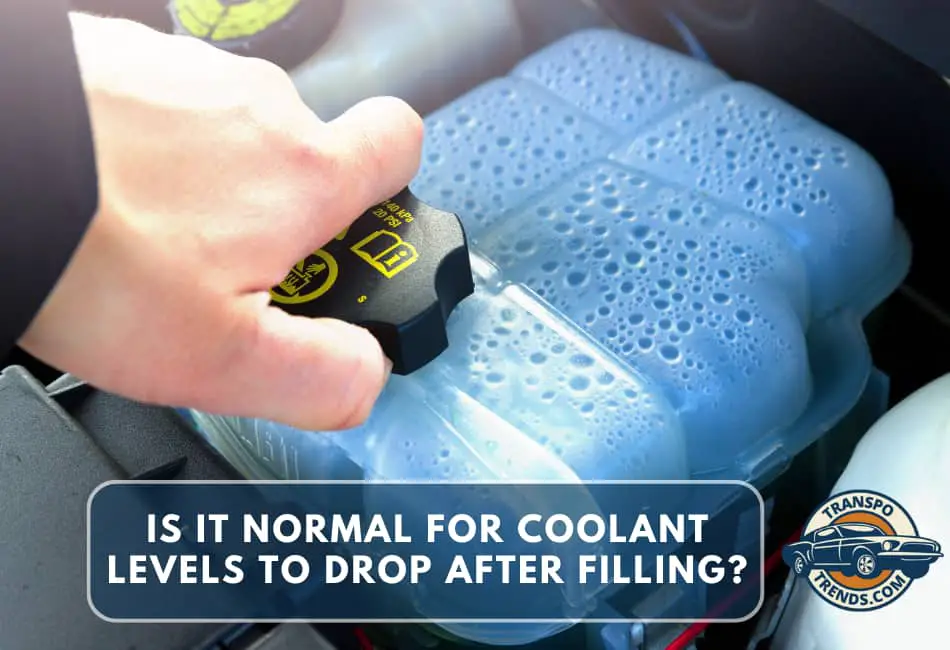Understanding your vehicle’s cooling system is crucial to maintain its performance and longevity. One key component of this system is the coolant or antifreeze.
This essential fluid helps regulate your engine’s temperature, preventing it from overheating in the summer and freezing in the winter.
But you may ask, is it normal for coolant levels to drop after filling? This blog post aims to shed light on this question.
We will explore the role of coolant, factors affecting its levels, how to diagnose and address coolant level issues, and preventative measures to maintain optimal coolant levels. As usual, buckle up as we journey into the intricacies of your vehicle’s cooling system.
Understanding the Role of Coolant
What is Coolant (Antifreeze) and Its Significance In Vehicle Engines?
Coolant, or antifreeze, is a vital fluid crucial to your vehicle’s engine. Its primary function is to absorb heat from the engine and disperse it through the radiator, thus preventing the engine from overheating.
The coolant achieves this through a mixture of water and antifreeze, a chemical compound that lowers the freezing point and elevates the mixture’s boiling point.
This unique coolant property allows it to maintain its liquid state throughout an engine’s wide range of temperatures, from freezing winters to sweltering summers.
Importance of Maintaining the Correct Coolant Level
Maintaining the correct coolant level is paramount for the health of your vehicle’s engine. A low coolant level can lead to inadequate heat dispersion, causing the engine to overheat and potentially significantly damaging engine components.
Conversely, excess coolant can result in pressure build-up, leading to leaks and other damages to the cooling system.
Therefore, it is crucial to maintain the correct coolant level, ensuring the engine operates at an optimal temperature and prolonging the life of your vehicle.
Factors Affecting Coolant Levels
Common Reasons for Fluctuations in Coolant Levels
Several factors can cause coolant levels to fluctuate within your vehicle. Understanding these can help you better maintain your vehicle’s cooling system and prevent potential engine damage.
1. Coolant Leak
A coolant leak is one of the most common causes of fluctuating coolant levels. This can occur due to a damaged or worn-out hose, a failing water pump, or a cracked radiator.
Coolant leaks can be identified by the presence of a bright, often green or orange fluid beneath your vehicle.
If you suspect a coolant leak, it must be inspected and repaired immediately to prevent engine overheating.
2. Overheating and Expansion
An overheating engine can cause the coolant to expand and overflow from the coolant reservoir.
This can happen if the engine runs too hot due to a faulty thermostat, a blocked radiator, or a malfunctioning water pump.
It is essential to monitor your engine’s temperature regularly and have any overheating issues addressed promptly.
3. Trapped Air in the System
Trapped air in the cooling system can also lead to fluctuations in coolant levels. The air can create pressure imbalances within the system, causing the coolant to be pushed out of the reservoir.
This is often the result of improper coolant replacement or a faulty radiator cap. It’s recommended to bleed the cooling system of air for optimal performance.
4. Evaporation Over Time
Lastly, coolant evaporation can lead to decreasing coolant levels over time. While this is a normal process, it can still affect the overall performance of your vehicle’s cooling system.
Regularly checking and topping up your coolant can help maintain the required level and ensure effective heat dissipation.
It’s important to keep an eye on your vehicle’s coolant levels, as they can affect the overall performance of its cooling system.
If you notice any signs of fluctuating coolant levels, it is recommended to have them inspected and addressed immediately by a professional mechanic.
Regular maintenance and proper care ensure optimal engine performance and longevity.
Diagnosing and Addressing Coolant Level Issues
Importance of Regular Vehicle Maintenance and Inspection
Regular vehicle maintenance and inspection are crucial for the longevity and performance of your vehicle.
Routine checks can identify potential issues early and prevent them from escalating into costly repairs. Your coolant system is no exception.
Regularly inspecting coolant levels and the overall cooling system can ensure it’s functioning optimally, preventing overheating and engine damage.
Steps to Take if You Notice a Significant Drop in Coolant Levels
- Check for visible leaks: The first step is to inspect your vehicle for visible leaks. Puddles of coolant under your car or coolant residue on engine parts indicate a leak that needs immediate attention.
- Monitor engine temperature: A rise in engine temperature may be due to low coolant levels. Always keep an eye on the temperature gauge, and if it indicates overheating, stop driving and let the engine cool down.
- Inspect the cooling system for trapped air: Trapped air in the cooling system can push coolant out of the reservoir. If coolant levels drop without visible leaks, it could be due to air in the cooling system.
- Consider the age and condition of the vehicle: Older vehicles or those in poor condition might experience a natural reduction in coolant levels due to evaporation or minor leaks. Regular top-ups can help maintain appropriate levels.
Preventative Measures for Maintaining Coolant Levels
Tips for Preventing Coolant Leaks
Preventing coolant leaks is essential for maintaining your car’s performance. Regularly inspect the hoses and connections for signs of wear and tear.
Replace any cracked or aged hoses immediately to prevent leaks. Additionally, monitor your vehicle’s temperature gauge; an unusually high reading may indicate a coolant leak.
Maintaining the Correct Coolant Mixture Ratio
Maintaining the correct coolant mixture ratio is critical for the optimum functioning of your vehicle’s cooling system.
The ideal mixture is typically 50:50 antifreeze and water. This solution offers the best balance of freezing and boiling protection while preventing corrosion within the cooling system.
Regularly Checking and Topping Up Coolant Levels
Regularly check your vehicle’s coolant levels, especially before long trips. The coolant reservoir has a minimum and maximum line.
The coolant level should always be between these two lines. If the coolant level falls below the minimum line, top up the system with the appropriate coolant mixture.
Replacing Coolant When Necessary
It’s advisable to completely replace the coolant in your vehicle every 30,000 miles or as the manufacturer recommends.
Over time, coolant can become contaminated, reducing its effectiveness. A complete coolant system flush and refill will ensure your cooling system is filled with fresh, uncontaminated coolant, thus ensuring your engine remains at its optimal operating temperature.
Conclusion
In conclusion, maintaining your vehicle’s coolant system is crucial for its overall performance and longevity.
We’ve discussed key preventative measures such as regular inspections for leaks, maintaining the correct coolant mixture ratio, keeping an eye on coolant levels, and replacing coolant when necessary.
These simple but vital steps can save you from unnecessary repair costs and help your vehicle function at its best.
Never underestimate the importance of prompt action when it comes to coolant-level issues.
Delaying the necessary inspections and repairs can lead to more serious problems like engine overheating, which can devastate your vehicle’s engine.
Lastly, we encourage all vehicle owners to stay informed and proactive regarding their cooling systems.
Your vehicle is an investment, and understanding how to care for it, including the cooling system properly, is an essential part of being a responsible vehicle owner.

